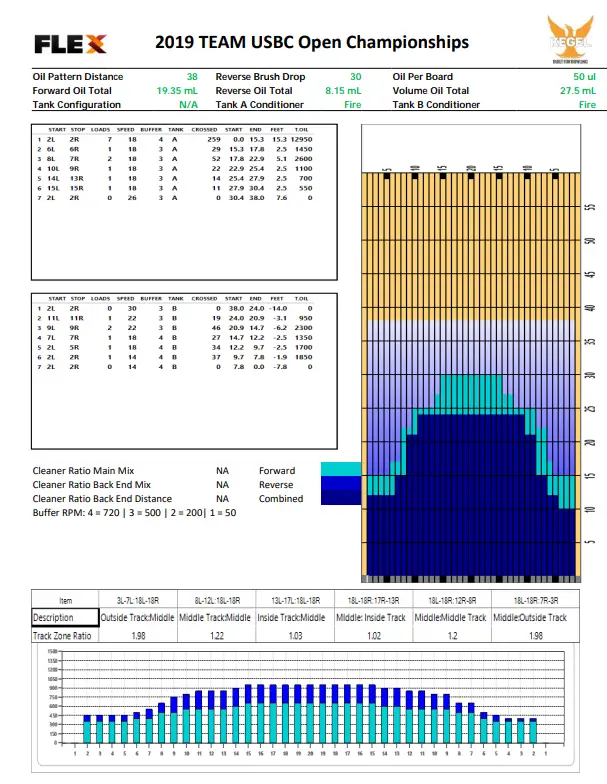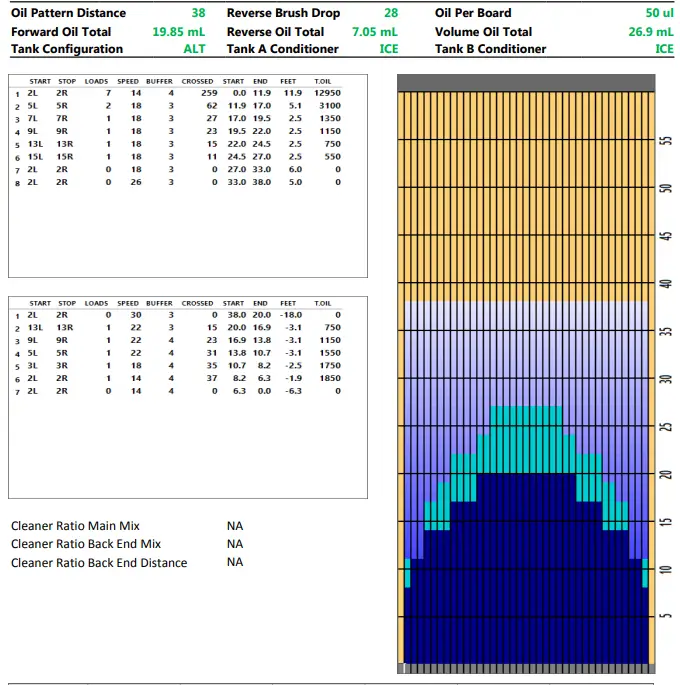
Every year the USBC Nationals puts a pretty tough oil pattern down for competition.
The Open Championships team event is bowled on fresh oil and (with five man teams bowling three games each) the pattern can break down significantly when all 10 bowlers on a pair know what to do.
Over three games a full 30 games can be bowled on a pair of lanes! That’s plenty of games for a team to fully break down a pattern if everyone works together.
Add in all the practice you get before game one even starts and any single pair can be broken down into a scorable shot if everybody is on board with a plan of attack.
This year the Open Championships has decided to not release the lane graph or detailed pattern data until after the tournament concludes in July.
[Edit]
Here is the team event oil pattern which was released after the event concluded.

In year’s past the pattern was available in advance of the tournament or at the start of the tournament in Late February to early March.
Considering the fact that everyone will compete on the pattern without the graph available for advance practice sessions we can only make educated speculation as to the length and volume of the pattern.
The years spanning 2010 through 2018 the USBC Open Championship’s shortest pattern was 38-feet which was used in 2015, 2016, 2017, and 2018 and the longest pattern was 43-feet which was used in 2014.
It’s a safe bet that the 2019 Open Championships oil pattern will fall between these lengths with a good bet being 38-41 feet.
► [EDIT] The pattern ended up being 38 feet in length.
What about volume of oil?
Since 2010 the 2017 Open Championships team even shot used the most volume of total oil – 29.45 mL. The 2018 team even was second using 28.4 mL.
Prior to that the lowest volume used was 24.4 mL back in the 2014 event and the third highest volume was 27.35 mL used in 2011 in Reno, NV.
What can we learn from this?
I’d say that the past four to five years have used more volume due to more aggressive bowling balls on the market and the least amount of volume was used on the longest pattern.
If we assume a pattern length of 40 feet then I would expect a volume of 26-28 mL to be used.
► [EDIT] The pattern ended up being 27.5 mL in total.
It’s unlikely that an extremely long, short, heavy, or light volume pattern will be used in this year – chances are best that it will be a slightly higher volume used based on the preceding four years of tournament play.
Lets consider the oil ratio of the outside to inside boards:
Since 2010 the “easiest” ratio of oil volume on the outside boards to the inside boards was in 2010 when the ratio was roughly 3 to 1.
Since then the trend of the pattern oil ratio has been flattening to less than 2 to 1.
2015, 2016, and 2017 all saw rations in the vicinity of 1.6 to 1 while 2017 and 2018 came in at around 1.8 to 1 and 1.9 to 1.
What does this mean?
For five years in a row the ratio has been less than 2:1 so I would expect something similar this year as well.
► [EDIT] The pattern ended up being a ratio of 1.98:1 – quite flat.
Generally the flatter the pattern is dictates a much straighter shot for practice and the early games while a friction zone is created by bowlers that can open up the lane and aid in a better scoring environment.
I would expect an up-the-boards approach through warm-up and at least game 1 to be almost a necessity this year.
Of course that leads us to pattern shape and breakdown.
What about pattern shape can we decipher?
Back in 2010 the main taper spanned boards 5 before the arrows to 13 just past the arrows and the ratio of oil outside to inside was 3 to 1.
Since then the ratio has gotten tighter or flatter and the shape has been “squished”.
2011 the main taper was between 6 and 13 and then it was between 5 and 12 in 2012.
In the following years it was between as follows:
7-12 in 2013
7-12 in 2014
4-14 in 2015
4-14 in 2016
4-14 in 2017
4-15 in 2018
► [EDIT] The taper in 2019 ended up being wide again spanning boards 5-14.
You would have to notice that in recent years the taper has not been steep but rather quite wide when compared to the years from 2010-2014.
2015 through 2018 had a taper that allowed many different angles to be played ranging from up the outside boards to crossing over the inside boards.
Taking the rule of 31 into account every bowler should be exiting the pattern at the same spot or within a couple boards of that spot regardless of where they release the ball at the foul line. You simply take the pattern length and subtract 31.
Higher rev players may be fine subtracting 32 and lower rev players may be fine subtracting 30 but for a 40 foot pattern the exit point should be around the 8-10 board at 40 ft, which is the start of the second hash mark down lane on the 10-board.
If the taper this year is anything like the past few years where it starts gradually tapering out in length at the 5-board all the way inside to the 14-board then you conceivably would have a decent release point for game one anywhere between 4 at the foul line to 22 at the foul line.
To break a pattern down however you have to burn up the outside part of the breakpoint without burning up the inside oil volume and that requires a somewhat straighter shot.
Taking the recent history of the Open Championships patterns into consideration I would wager a bet that the ideal exit break point be around the 9-board depending on the style of the bowler.
Considering that the past shows us that the pattern’s oil taper starts around the 5-board you should be able to go straight up the 5 board with a weak ball that then crosses the 8-board at the break point (40-feet down lane). This will burn a spot at the break point for games two and three without affecting the inside line that you will transition to with your stronger balls.
In effect practice and game 1 is all about making a 2:1 ratio pattern feel like a 4 or 5 to 1 ratio shot by games two and three.
If every single bowler on a pair spends their time during warm-up diligently hitting the same exit point on the lane with a ball that goes up the outside boards then a burn spot should emerge in short order making the lane much more playable for games two and three.
My Prediction
For 2019 the USBC Nationals oil pattern is likely 39 feet long, meaning the oil pattern exit point should be around board 7-9 depending on the bowler. There will probably be around 27-28 mL of oil making it feel pretty slick to many bowlers, especially those with low RPM, high speed deliveries, or those using older/weaker equipment.
I expect the taper to be wide allowing for a wide range of angles to the pocket but only after sufficient oil pattern breakdown occurs.
The volume of oil is pretty heavy compared to most house conditions as this is typical for the Nationals tournament.
Bowers and teams achieving the most success will most likely see a lot of up the boards play in warm-up and in game 1 before the majority of bowlers are able to ball-up to their stronger equipment to take advantage of small burn spots carved into the break-point through the early frames of competition.
In most cases the 10 people bowling on any given pair will consist of a mix of different styles of play using different ball speeds, rev rates, and coverstocks.
The heavy oil doesn’t usually help pairs that include lots of low rev players of different styles although it certainly can if everyone is particularly accurate and on the same page.
If however you are fortunate enough to be on a pair that includes lots of bowlers that play in your area with more revs than average then the pattern can be broken down much faster and it can become playable in relatively short order.
In years past the teams that score the best at Nationals tend to have bowlers that all have similar styles and they all work together as a team.
It does no team much good for only a single player to bowl well. If everybody plays roughly the same line and hits roughly the same exit point on the pattern then most bowlers will score high enough to put up some impressive team numbers.
2019 will represent the 119th USBC Nationals bowling tournament and there’s no reason this even will be any different than events of the past.
These days the oil pattern isn’t announced months in advance; it’s announced in the days after the last squads end bowling in July.
In many ways the bowlers shoeing up in early July used to have an advantage, they were able to practice on the pattern for a few months before their squad began.
Last year, in 2018, the oil pattern for the USBC Nationals tournament wasn’t released until early March but in year’s past the pattern has been released to the public as early as February in 2017 and 2016, and as early as January in years prior to that.
This year, 2019 we are patiently waiting for the March tournament to begin. It is slated for bowling dates between March 9, 2019 and July 7, 2019.
The announcement of the official oil pattern for the 2019 Open Championships isn’t formally going to be released until after the tournament concludes but we can really glean a lot of information by looking at the history of the tournament and as we watch the top bowlers and teams compete through the Spring and early Summer.
When the lane graph is released MountsBowling.com will be one of the first to publicize it and comment on it. I love analysis. 🙂
Check this page frequently over the next few weeks because I will be constantly updating this page with tips on how to play the 2019 USBC Championship based on analysis of top bowlers and information that leaks out of the Los Vegas center.
Here is the pattern graph for the Open Championships which was contested a few years ago. I think it’s going to be the closest guess as to this years pattern prior to it’s release.

For the actual 2019 pattern, scroll back up to the top of the page or click this jump link.

